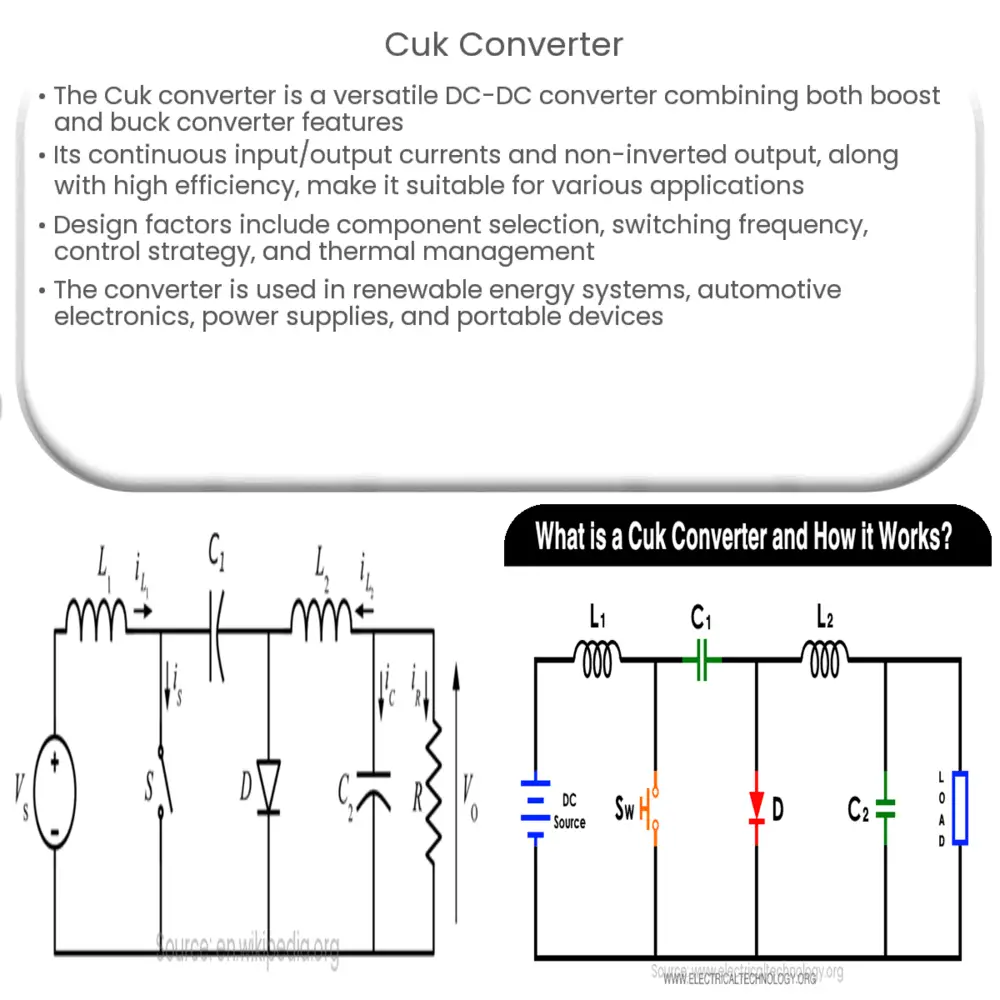The Cuk converter is an efficient, versatile DC-DC power converter that offers non-inverted output, continuous currents, and high performance for various applications.

Cuk Converter: An Overview of the Versatile Power Electronic Converter
The Cuk converter, named after its inventor Slobodan Ćuk, is a versatile and efficient power electronic converter that has gained popularity in various applications, ranging from renewable energy systems to automotive electronics. This article aims to provide an insight into the fundamentals of Cuk converters, their operational principles, and advantages over other converter topologies.
What is a Cuk Converter?
A Cuk converter is a type of switched-mode power supply (SMPS) that belongs to the family of DC-DC converters. It is designed to efficiently convert an input DC voltage to a regulated output voltage, which can be either higher or lower than the input voltage. Unlike other converters, the Cuk converter uniquely combines the functionality of both the boost and the buck converter, making it suitable for a wide range of applications.
Operational Principle of the Cuk Converter
The basic Cuk converter topology consists of two inductors, two capacitors, a diode, and a switch (usually a MOSFET). The operation of the Cuk converter can be divided into two main stages: the ON state and the OFF state.
ON State: During the ON state, the switch is closed, allowing the input voltage to charge the first inductor (L1). Simultaneously, the energy stored in the second capacitor (C2) is transferred to the load through the second inductor (L2). In this stage, the diode is reverse-biased, and no current flows through it.
OFF State: When the switch opens, the energy stored in L1 is transferred to the second capacitor (C2) and the load through the diode. At the same time, L2 continues to transfer the energy stored in C2 to the load. The output voltage is regulated by controlling the duty cycle of the switch, which is the ratio of the ON time to the total switching period.
Advantages of the Cuk Converter
There are several advantages that make the Cuk converter an attractive choice for power conversion applications:
- Non-inverted Output: Unlike other topologies such as the buck-boost converter, the Cuk converter provides a non-inverted output, which means the output voltage polarity is the same as the input voltage polarity.
- Continuous Input and Output Currents: Due to the presence of two inductors, the Cuk converter maintains continuous input and output currents, resulting in lower ripple and reduced electromagnetic interference (EMI).
- High Efficiency: The Cuk converter offers high efficiency, especially at high step-up or step-down ratios, due to its unique topology and minimized energy storage requirements.
In conclusion, the Cuk converter offers a unique combination of features that make it suitable for a variety of power conversion applications, such as renewable energy systems, automotive electronics, and portable devices. In the following section, we will delve deeper into the design considerations and practical implementation of the Cuk converter.
Design Considerations for the Cuk Converter
When designing a Cuk converter, there are several factors that need to be considered to ensure optimal performance and reliability:
- Component Selection: The choice of inductors, capacitors, diode, and switch play a crucial role in determining the overall efficiency and performance of the Cuk converter. High-quality, low-loss components are essential to maximize efficiency and minimize heat dissipation.
- Switching Frequency: The switching frequency directly impacts the size of the inductors and capacitors, as well as the efficiency and output ripple. A higher switching frequency allows for smaller components but may lead to increased switching losses and reduced efficiency.
- Control Strategy: The output voltage regulation can be achieved through various control strategies such as voltage-mode control, current-mode control, and hysteresis control. The choice of control strategy affects the transient response, stability, and output voltage ripple.
- Thermal Management: Effective thermal management is crucial for ensuring the reliability and long-term stability of the Cuk converter. Proper heat sinking and airflow management are necessary to maintain the temperature of critical components within safe operating limits.
Practical Applications of the Cuk Converter
Due to its versatility and high efficiency, the Cuk converter has found its way into a variety of applications:
- Renewable Energy Systems: In solar and wind energy systems, the Cuk converter can be used for maximum power point tracking (MPPT) and voltage regulation, ensuring maximum energy extraction from the renewable sources.
- Automotive Electronics: Cuk converters can be employed in electric vehicles and hybrid electric vehicles for power management tasks, such as voltage regulation and battery charging.
- Power Supplies: The Cuk converter’s ability to provide both step-up and step-down voltage conversion makes it suitable for a wide range of power supply applications, including AC-DC and DC-DC converters.
- Portable Devices: In portable electronics, such as smartphones, tablets, and laptops, the Cuk converter can be used to efficiently regulate voltage levels for various subsystems and components.
Conclusion
The Cuk converter is a versatile and efficient power electronic converter that offers several advantages over other converter topologies. Its unique combination of features, such as non-inverted output, continuous input and output currents, and high efficiency, make it an attractive choice for various applications. By carefully considering design factors and employing proper control strategies, the Cuk converter can be effectively utilized in renewable energy systems, automotive electronics, power supplies, and portable devices, among others.

